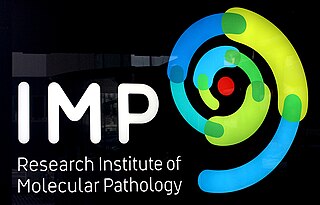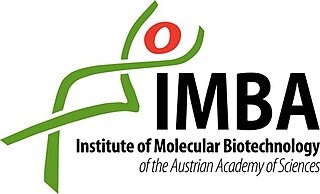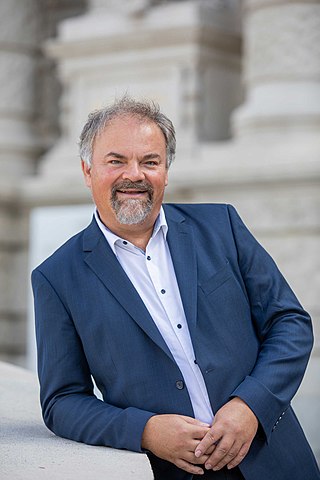Related Research Articles

Microscopy is the technical field of using microscopes to view objects and areas of objects that cannot be seen with the naked eye. There are three well-known branches of microscopy: optical, electron, and scanning probe microscopy, along with the emerging field of X-ray microscopy.

Cathodoluminescence is an optical and electromagnetic phenomenon in which electrons impacting on a luminescent material such as a phosphor, cause the emission of photons which may have wavelengths in the visible spectrum. A familiar example is the generation of light by an electron beam scanning the phosphor-coated inner surface of the screen of a television that uses a cathode-ray tube. Cathodoluminescence is the inverse of the photoelectric effect, in which electron emission is induced by irradiation with photons.

A fluorescence microscope is an optical microscope that uses fluorescence instead of, or in addition to, scattering, reflection, and attenuation or absorption, to study the properties of organic or inorganic substances. "Fluorescence microscope" refers to any microscope that uses fluorescence to generate an image, whether it is a simple set up like an epifluorescence microscope or a more complicated design such as a confocal microscope, which uses optical sectioning to get better resolution of the fluorescence image.

Two-photon excitation microscopy is a fluorescence imaging technique that is particularly well-suited to image scattering living tissue of up to about one millimeter in thickness. Unlike traditional fluorescence microscopy, where the excitation wavelength is shorter than the emission wavelength, two-photon excitation requires simultaneous excitation by two photons with longer wavelength than the emitted light. The laser is focused onto a specific location in the tissue and scanned across the sample to sequentially produce the image. Due to the non-linearity of two-photon excitation, mainly fluorophores in the micrometer-sized focus of the laser beam are excited, which results in the spatial resolution of the image. This contrasts with confocal microscopy, where the spatial resolution is produced by the interaction of excitation focus and the confined detection with a pinhole.

Stimulated emission depletion (STED) microscopy is one of the techniques that make up super-resolution microscopy. It creates super-resolution images by the selective deactivation of fluorophores, minimizing the area of illumination at the focal point, and thus enhancing the achievable resolution for a given system. It was developed by Stefan W. Hell and Jan Wichmann in 1994, and was first experimentally demonstrated by Hell and Thomas Klar in 1999. Hell was awarded the Nobel Prize in Chemistry in 2014 for its development. In 1986, V.A. Okhonin had patented the STED idea. This patent was unknown to Hell and Wichmann in 1994.
RESOLFT, an acronym for REversible Saturable OpticaLFluorescence Transitions, denotes a group of optical fluorescence microscopy techniques with very high resolution. Using standard far field visible light optics a resolution far below the diffraction limit down to molecular scales can be obtained.

Stefan Walter Hell is a Romanian-German physicist and one of the directors of the Max Planck Institute for Multidisciplinary Sciences in Göttingen, and of the Max Planck Institute for Medical Research in Heidelberg, both of which are in Germany. He received the Nobel Prize in Chemistry in 2014 "for the development of super-resolved fluorescence microscopy", together with Eric Betzig and William Moerner.

The Max Planck Institute for Medical Research in Heidelberg, Germany, is a facility of the Max Planck Society for basic medical research. Since its foundation, six Nobel Prize laureates worked at the Institute: Otto Fritz Meyerhof (Physiology), Richard Kuhn (Chemistry), Walther Bothe (Physics), André Michel Lwoff, Rudolf Mößbauer (Physics), Bert Sakmann and Stefan W. Hell (Chemistry).

Ground state depletion microscopy is an implementation of the RESOLFT concept. The method was proposed in 1995 and experimentally demonstrated in 2007. It is the second concept to overcome the diffraction barrier in far-field optical microscopy published by Stefan Hell. Using nitrogen-vacancy centers in diamonds a resolution of up to 7.8 nm was achieved in 2009. This is far below the diffraction limit (~200 nm).
Winfried Denk is a German physicist. He built the first two-photon microscope while he was a graduate student in Watt W. Webb's lab at Cornell University, in 1989.
Christoph Cremer is a German physicist and emeritus at the Ruprecht-Karls-University Heidelberg, former honorary professor at the University of Mainz and was a former group leader at Institute of Molecular Biology (IMB) at the Johannes Gutenberg University of Mainz, Germany, who has successfully overcome the conventional limit of resolution that applies to light based investigations by a range of different methods. In the meantime, according to his own statement, Christoph Cremer is a member of the Max Planck Institute for Chemistry and the Max Planck Institute for Polymer Research.

Vertico spatially modulated illumination (Vertico-SMI) is the fastest light microscope for the 3D analysis of complete cells in the nanometer range. It is based on two technologies developed in 1996, SMI and SPDM. The effective optical resolution of this optical nanoscope has reached the vicinity of 5 nm in 2D and 40 nm in 3D, greatly surpassing the λ/2 resolution limit applying to standard microscopy using transmission or reflection of natural light according to the Abbe resolution limit That limit had been determined by Ernst Abbe in 1873 and governs the achievable resolution limit of microscopes using conventional techniques.

The Research Institute of Molecular Pathology (IMP) is a biomedical research center, which conducts curiosity-driven basic research in the molecular life sciences.

The Institute of Molecular Biotechnology (IMBA) is an independent biomedical research organisation founded by the Austrian Academy of Sciences in cooperation with the pharmaceutical company Boehringer Ingelheim. The institute employs around 250 people from over 40 countries, who perform basic research. IMBA is located at the Vienna BioCenter (VBC) and shares facilities and scientific training programs with the Gregor Mendel Institute of Molecular Plant Biology (GMI) of the Austrian Academy of Sciences and the Research Institute of Molecular Pathology (IMP), the basic research center of Boehringer Ingelheim.
Super-resolution microscopy is a series of techniques in optical microscopy that allow such images to have resolutions higher than those imposed by the diffraction limit, which is due to the diffraction of light. Super-resolution imaging techniques rely on the near-field or on the far-field. Among techniques that rely on the latter are those that improve the resolution only modestly beyond the diffraction-limit, such as confocal microscopy with closed pinhole or aided by computational methods such as deconvolution or detector-based pixel reassignment, the 4Pi microscope, and structured-illumination microscopy technologies such as SIM and SMI.
Photo-activated localization microscopy and stochastic optical reconstruction microscopy (STORM) are widefield fluorescence microscopy imaging methods that allow obtaining images with a resolution beyond the diffraction limit. The methods were proposed in 2006 in the wake of a general emergence of optical super-resolution microscopy methods, and were featured as Methods of the Year for 2008 by the Nature Methods journal. The development of PALM as a targeted biophysical imaging method was largely prompted by the discovery of new species and the engineering of mutants of fluorescent proteins displaying a controllable photochromism, such as photo-activatible GFP. However, the concomitant development of STORM, sharing the same fundamental principle, originally made use of paired cyanine dyes. One molecule of the pair, when excited near its absorption maximum, serves to reactivate the other molecule to the fluorescent state.

Robert Eric Betzig is an American physicist who works as a professor of physics and professor of molecular and cell biology at the University of California, Berkeley. He is also a senior fellow at the Janelia Farm Research Campus in Ashburn, Virginia.

Jürgen Knoblich is a German molecular biologist. Since 2018, he is the interim Scientific Director of the Institute of Molecular Biotechnology (IMBA) of the Austrian Academy of Sciences in Vienna.
Ilaria Testa is an Italian-born scientist who is a Fellow at the SciLifeLab in Stockholm and an Associate Professor at the Department of Applied Physics at the School of Engineering Science at the KTH Royal Institute of Technology. She has made major contributions to advanced microscopy, particularly superresolution microscopy.
MINFLUX, or minimal fluorescence photon fluxes microscopy, is a super-resolution light microscopy method that images and tracks objects in two and three dimensions with single-digit nanometer resolution.
References
- ↑ "Francisco Balzarotti's lab at the IMP" . Retrieved 2023-07-19.
- ↑ https://www.linkedin.com/in/francisco-balzarotti/
- ↑ "Francisco Balzarotti | Light-based microscopy | Research Institute of Molecular Pathology (IMP)".
- ↑ "Stefan Hell".
- ↑ "Researchers achieve ultimate resolution limit in fluorescence microscopy".
- ↑ Balzarotti, Francisco; Eilers, Yvan; Gwosch, Klaus C.; Gynnå, Arvid H.; Westphal, Volker; Stefani, Fernando D.; Elf, Johan; Hell, Stefan W. (2017). "Nanometer resolution imaging and tracking of fluorescent molecules with minimal photon fluxes". Science. 355 (6325): 606–612. arXiv: 1611.03401 . Bibcode:2017Sci...355..606B. doi:10.1126/science.aak9913. hdl:11858/00-001M-0000-002C-2D9A-4. PMID 28008086. S2CID 5418707.
- ↑ "First multimessenger observation of a neutron-star merger is Physics World 2017 Breakthrough of the Year". 11 December 2017.
- ↑ "Researchers achieve ultimate resolution limit in fluorescence microscopy".
- ↑ Eilers, Yvan; Ta, Haisen; Gwosch, Klaus C.; Balzarotti, Francisco; Hell, Stefan W. (2018). "MINFLUX monitors rapid molecular jumps with superior spatiotemporal resolution". Proceedings of the National Academy of Sciences. 115 (24): 6117–6122. Bibcode:2018PNAS..115.6117E. doi: 10.1073/pnas.1801672115 . PMC 6004438 . PMID 29844182.
- ↑ Pape, Jasmin K.; Stephan, Till; Balzarotti, Francisco; Büchner, Rebecca; Lange, Felix; Riedel, Dietmar; Jakobs, Stefan; Hell, Stefan W. (2020). "Multicolor 3D MINFLUX nanoscopy of mitochondrial MICOS proteins". Proceedings of the National Academy of Sciences. 117 (34): 20607–20614. Bibcode:2020PNAS..11720607P. doi: 10.1073/pnas.2009364117 . PMC 7456099 . PMID 32788360.
- ↑ Gwosch, Klaus C.; Pape, Jasmin K.; Balzarotti, Francisco; Hoess, Philipp; Ellenberg, Jan; Ries, Jonas; Hell, Stefan W. (2020). "MINFLUX nanoscopy delivers 3D multicolor nanometer resolution in cells". Nature Methods. 17 (2): 217–224. doi:10.1038/s41592-019-0688-0. PMID 31932776. S2CID 256840140.
- ↑ "Francisco Balzarotti | Light-based microscopy | Research Institute of Molecular Pathology (IMP)".
- ↑ https://www.balzarotti-lab.org/
- ↑ "Francisco Balzarotti | Research at a molecular biology institute when you are not a biologist". YouTube . 12 July 2023.
- ↑ "Seeing is Believing: Imaging the Molecular Processes of Life – Course and Conference Office".
- ↑ "Program".
- ↑ https://smlms.org/
- ↑ "ERC Starting Grants 2019 – List of Principal Investigators" (PDF). Retrieved 2023-07-19.
- ↑ "High-throughput 4D imaging for nanoscale cellular studies" . Retrieved 2023-07-19.
- ↑ "Francisco Balzarotti wins 2024 Frontiers of Science Award".